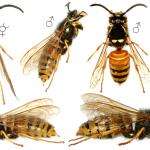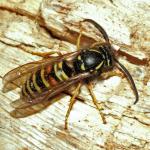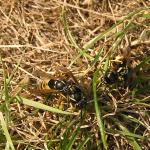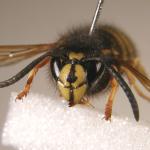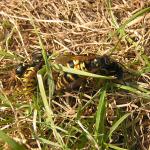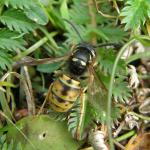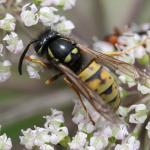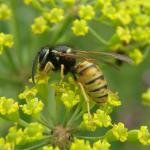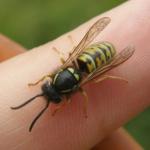Vespula grahami ARCHER 1981; Vespa intermedia DU BUYSSON 1905; Vespula obscura LEE 1986; Vespa schrenckii RADOSZKOWSKI 1861; Vespa sibiria ANDRÉ 1884; Vespula yichunensis LEE 1986
Identification keys and general biology of the Red Wasp are given in Spradbery (1973), Archer (1979, 1996, 1997a, 19976b), Edwards (1980), Akre et al. (1981) and Else (1994).
Found throughout England, Wales, Scotland and Ireland. It also occurs on the Isle of Man, the Channel Islands and the Outer Hebrides, but not on Orkney, Shetland, or the Isles of Scilly.
Overseas it occurs in central and northern Europe to about 70° north. It is also widely distributed across Asia and North America.
This species is not regarded as being scarce or threatened.
Open situations, e.g. open woodlands, moorland and hedge banks, less commonly in urban situations. Nests are usually underground in a dry, often shaded situation, close to the soil surface, even just under the leaf litter or moss layer. Also in hollow tree stumps and suspended from roots of trees in hollows in the ground. Nests are rare above ground (in dense bushes, cavity walls, bird boxes and eaves of houses) but less so in towns.
This social wasp has an annual life-history with the overwintering queens emerging from late March until early May, with the first workers emerging as adults from the end of May until mid-June. New sexuals emerge from late July; mating usually from early August. After mating males die and females enter overwintering sites. The remaining colony dies during September.
Principal food of the larvae is usually insects and spiders.
The queen constructs the initial 'queen nest' and rears the first workers. These workers start to forage and carry out all the nest building and brood rearing activities. The first cells, in which the workers and most of the males are reared, are small (about 4 mm diameter). Later in the season larger cells (about 6 mm diameter) are built, in which the queens and a few males are reared. On average the mature nest consists of about 500 small and 500 large cells in three combs. A colony generally rears about 450 workers, 180 males and 200 queens.
Spradbery (1973) lists 23 species, including figwort, wild parsnip, black currant, gorse and cotoneaster.
Spradbery (1973) gives much information including the fly Conops flavipes as an endoparasite; the beetle Metoecus paradoxus as a larval parasitoid; and the larvae of the hoverfly Volucella pellucens as scavengers. Great tits Parus major and badgers Meles meles have been reported as predators, the latter digging out nests from cavities in the soil.
2001


